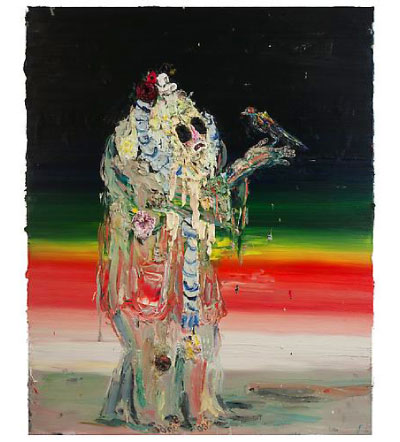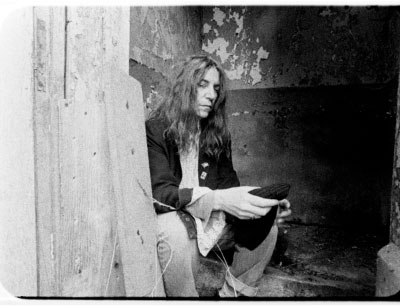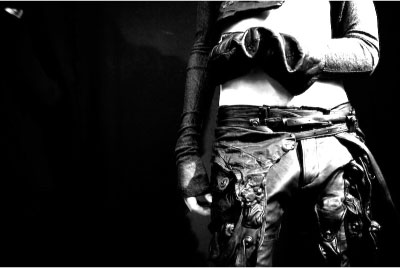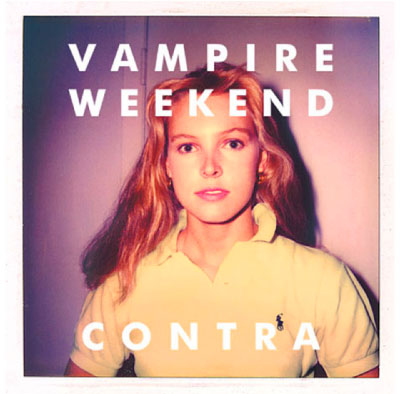
Man With Bird, Allison Schulnik 2009. Images courtesy of Mark Moore Gallery

Allison Schulnik paints rejects. For her second solo exhibit at the Mark Moore Gallery, aptly titled Home for Hobo, the Los Angeles based artist focuses on one of her recurring subjects — the hobo clown — to extend her family of outcasts to include possums, raccoons, and Klaus Kinski. Comprising ten paintings, four sculptures, and a four-minute claymation music video for Grizzly Bear, all dated 2009, Schulnik’s new work embodies the same macabre sensibilities of her previous works, utilizing kitsch subject matter in the traditional formats of portraiture, landscape, and still life. Refreshingly honest, Schulnik’s work is that of excess. Caked in thickly applied impasto, her fantastical characters appear to be melting off the canvas, residing somewhere between their world and ours. Schulnik remarks, “It just felt right for the characters that they should not be so together. They’re falling off of their skeleton, they’re falling off of their own frame.” Simultaneously stunning and unsettling, the characters stare longingly for something that only exists within their fictional frames — beauty, love, refuge, recognition.
Growing up in San Diego, Schulnik describes her childhood as unstructured. “I went around town making art and being bad and being good.” Trained in different forms of dance, Schulnik left the art of moving for the art of the moving picture. Attending the California Institute of the Arts, Schulnik received her BFA in Experimental Animation in 2000. After graduating, Schulnik worked in studio animation for about six years before transitioning entirely to her solo work. A lover of all the archaic forms of art making, Schulnik is a purist at heart.
(more…)


Mad Decent /Asylum records


Typically a mixtape is just enough to whet your appetite for the official release, serving the essential purpose of leaking songs and then becoming a throwaway once the real deal comes out. Not so in the hands of Diplo. In fact, in recent years his mixtapes in advance of debuts for artists such as M.I.A. and Santigold have become as lasting as their studio efforts, return-to listens long after their release, and even companion pieces to those great albums. After a reggae/dancehall sabbatical with Major Lazer in 2009, the venerable DJ returns once again to his first and true love, hip hop, with Free Gucci: Best of the Cold War Mixtapes. Gucci Mane is arguably the hottest voice in hip hop right now, MySpace’s top rap artist of ‘09, with supposedly another two albums on the way this year despite being incarcerated for violating probation. He’s best described as a “playful gangster” with a lazy vocal delivery, cheeky streetwise lyrics that are simultaneously crack-up and G’d up, and hooks that make it no wonder people keep coming back. The genius here is Diplo’s matchmaking between recent electronic music breakouts as remixers (Flying Lotus, Zomby, Memory Tapes) with vocals they’d never think to use; it simultaneously introduces hipster music geeks to the newest crunk and hip hop heads to up and coming electro beatmakers. Oh yeah, and like the best mixtapes, it’s free. Grab it at Mad Decent.
Audio clip: Adobe Flash Player (version 9 or above) is required to play this audio clip. Download the latest version here. You also need to have JavaScript enabled in your browser.




“I always felt somethin’ different stirrin’ in me,” declares a young Patti Smith in Dream of Life, the recent documentary film about her. That young girl’s instincts were right, and in the decades since she spoke those words, Smith has emerged as a radical figure even in the progressive world of rock and roll: a feminine tomboy who led a rock movement while maintaining her fangirl love of the counterculture. The film captures that essence, which is further distilled for Patti Smith and Steven Sebring: Objects of Life, a collaborative show with the filmmaker inspired by the eleven years it took to make the movie. On view at Chelsea’s Robert Miller Gallery, it includes a collection of art, photographs and objects from both artists, and though Sebring is a collaborator, Smith is the star. The show is a paean to her, and to her artistic diversity.
Though Smith is best known as a musician, she is also an accomplished poet and visual artist, and the show leads you through her talents. On view are a number of her ghostly black-and-white photographs, notably as part of her tribute to Arthur Rimbaud, the 19th-century French poet, which is centered on a haunting recreation of his death litter. Smith’s drawings are also a highlight, with their loose, scratchy lines, delicate colors, and emphasis on symbology. Smith dedicates one gallery to her friendship with the photographer Robert Mapplethorpe, a touching installation that alludes to Just Kids, a new memoir by Smith about their shared youth that reminds you Smith is a writer who has always been loud about her influences.
(more…)


Smalltown Supersound

Since the Bergen-reared, Berlin-based Annie Lilia Berge Strand released her breakout album, Anniemal, in 2004 the pop music landscape has changed dramatically, particularly with respect to genre-straddling female artists with one foot firmly entrenched in indie waters and the other dipped in pop territory. Her second full-length album, Don’t Stop — long-delayed and substantially reworked after creative differences with Island Records — arrived in late 2009, a post-Ladyhawke, post-Little Boots, post-Lykke Li moment. But Don’t Stop differentiates Annie from this pack of indie-electro darlings for whom she opened the doors. The album is a mixed bag in the best possible sense. Its songs run the gamut, from the dance confection “My Love is Better” to the moody, melodic, French-pop-inflected “Marie Cherie”. And Annie has chosen a diverse set of collaborators, including Alex Kapranos of Franz Ferdinand and producers Xenomania, who have worked with Kylie Minogue, Saint Etienne and the Pet Shop Boys, reflecting her repudiation of a sound that is one note.
PLANET caught up with Annie as she readied herself for a year of touring to support Don’t Stop as well as continuing her regular DJ gigs at home and abroad.
Audio clip: Adobe Flash Player (version 9 or above) is required to play this audio clip. Download the latest version here. You also need to have JavaScript enabled in your browser.
Buy this at iTunes.
(more…)


Photography by Jeff Antebi (Click images for slideshow)


In light of the earthquake and ensuing tragedy in Port-au-Prince, Haiti yesterday, we’d like to encourage our readers to help in any way they are able. Here are links to two international aid organizations that have longstanding and effective aid efforts on the ground there, Oxfam and Doctors Without Borders. We just made a donation on behalf of PLANET through Oxfam and hope many of you will, too, whether through these organizations or others you support. Haiti is only 100 miles from South Florida and has been the most neglected country in our part of the world. The magnitude of the death toll, estimated to be over 100,000, has much to do with poor housing and infrastructure throughout the city and countryside. The people there will simply not be able to cope, nor the country recover, without help from the rest of the world.
Photographer Jeff Antebi, whose work on Juarez we published earlier this week, made many trips to Haiti in the last several months photographing the people there, who, despite crushing poverty – the worst in the Western Hemisphere – maintain an irrepressible spirit. We wanted to include these images to put a human face on the tragedy as well as to show the innately beautiful spirit of the people. Obviously these images are in stark contrast to the scenes we have been seeing out of Haiti for the last day. The safety of the people in these images, photographed a few short months ago, is not known, but certainly all of them have suffered and are still suffering. Please help the people of Haiti and help us spread the word.
(more…)




Black is the most misunderstood color. In fashion, black has been co-opted by two groups of people: the Balmain-sporting fashionistas who think that chic is a value in itself, and the misguided (by Hot Topic) teenagers who worship Satan and Marilyn Manson in the safety of their suburban homes. But black is not the color of chic or nihilism. For Tatsuro Horikawa, the young Japanese designer behind the cult clothing label Julius, black is the color of depth. It is not there to promote aggression and destruction – the pop version of black – but to display his awareness of the world that is subject to aggressive and destructive forces. And, as unexpected as it might sound, it is also a color of hope. “Black is the color of complete and utter grief,” says Horikawa’s manifesto, “and redemption through atonement.” This view is a kind of existentialism – the idea that we alone are responsible for our fate and carry the full burden of responsibility for our actions, and thus must bear witness to the world’s evil. This view can be easily traced in Horikawa’s uncompromising designs – the oiled leather jackets, heavy jeans with multiple pockets, and drapey, shredded tops. Their purposeful ruin is the reflection of our imperfection. But these clothes are also indestructible, like the human spirit.
Horikawa started out as a graphic designer in the late ’90s, forming a Tokyo-based art collective that produced multimedia installations. He considers the clothes to be the project’s extension.
(more…)




When I mentioned I was going to spend Christmas photographing Juárez, people reacted as if I was planning a trip to Somalia.
They were not that far off.
How out of control is the city of Juárez? Compare the killings there to the war in Afghanistan. In Juárez in 2009 — a single city with only 1.5 million people — almost 2,600 people have been murdered. The number of civilians killed in 2009 in the war in Afghanistan, a nation of 28 million people, was about 2038.
In the last two years, upwards of 4,000 people have been murdered in Juárez, compared to about thirty homicides across the U.S. border in El Paso.
Juárez is the deadliest city in the world for a simple reason: for years, several powerful drug cartels have been fighting over control of the city. The region represents an extremely profitable route into the U.S., where consumers spend enormous sums of money to get high. On average, ten people are murdered each day. In September alone, 476 people were killed, most of them gunned down in the street in broad daylight.
Juárez has become synonymous with murder, but the murders here are extraordinary brutal.
(more…)



One glance would make you think Los Angeles-based designer Austin Sherbanenko specializes in outfitting metal bands or partying with Andrew W.K. His clothing does indeed carry a strong goth-rock influence; but that flavor, mixed with good old-fashioned skilled design, makes for a mature collection that’s more haute than Hot Topic. Sherbanenko’s brainchild since 2007, Odyn Vovk officially launched with its Spring/Summer 2009 collection. Now with his Spring/Summer 2010 collection, Confined Translation, Sherbanenko is a designer with a solid aesthetic; he knows his audience because he is his audience. This season in particular tells the story “of past events: distant, near, and natural.” Symbolism in the collection includes “dirt-ridden streets, industrial landscapes, and sounds of music.” Odyn Vovk, Ukrianian for “One Wolf”, suggests strength, independence, and resourcefulness. Odyn Vovk’s site states that in “Celtic tradition, Wolf represents learning, loyalty, intuition, and the shadow … cunning, wisdom, searching, dreams, magic, transformation, death, rebirth, and protection.” Sherbanenko chooses black to dominate his collections because the solid color allows design intricacies to shine through. Structure is key, whether it’s the subtle drapery of loose, asymmetrical hoodies or the stronger contour and weight of a leather-sleeved jacket. The familiar and looser shapes ground the pieces, while classic shapes with minor twists – a zip-up jacket with a collar that could cover half your face, or a dress-length zippered vest – add elements of character, creativity, and construction.
(more…)


XL Recordings


Having received an endless stream of hype for their self-titled debut, this quartet will finally release their much anticipated sophomore set next week, and we couldn’t wait to share our impressions. If the debut was chiefly defined by Ezra Koenig’s lilting voice and soukous-style of guitar, the power of this second record very much resides in the hands (and dials) of Rostam Batmanglij’s arsenal of instruments and skilled studio work. In fact, Contra’s ten tracks ostensibly diverge on two paths: One (anchored by songs such as “Cousins” and “Holiday”) continues the jubilant pop that turned the debut into a surprise hit; the other boasts a more baroque strain of synths and samples — first demonstrated in October’s release of “Horchata” as well as on the reggae-tinged “Diplomat’s Son”, which appropriates vocals from M.I.A.’s “Hussel”. These distinct paths collide and culminate in standouts “Run” and “Giving Up the Gun”, in which carefree harmonies crash into digitized blips and beats. As Koenig sings on “Giving Up the Gun”: “Your sword’s grown old and rusty/Underneath the rising sun”, it almost seems the band is consciously trying to overcome the sophomore slump of sameness that doomed so many upstarts before. For that matter, even “Cousins” subverts the formula of earlier hit “A-Punk” by adding an aggressiveness we didn’t realize the band possessed. Thus, on this second album Vampire Weekend achieves the rare feat of honoring what earned them initial acclaim, while still evolving their style with an ambition that promises even more excitement in releases to come.
Watch “Cousins” after the jump. Buy this at Other Music or iTunes.
(more…)

Images courtesy of Rizzoli Books

In 1919, a revolutionary school opened in Weimar, Germany. It had a short life — only fourteen years — but it made history. Who among us today has not heard of the Bauhaus or isn’t familiar with its members, from founder Walter Gropius to artists Paul Klee and Wassily Kandinsky, to architect Mies van der Rohe? But there was more to the school than these few world-renowned men — there were, wouldn’t you know it, also many women.
History seems to have washed right over names like Marguerite Friedlaender-Wildenhain, Benita Otte, Gunta Stölzl, and Alma Siedhoff-Buscher, female Bauhaus students who made important contributions in fields such as ceramics, sculpture, weaving, and toy production. But now a new book by Ulrike Müller, simply titled Bauhaus Women and published by Rizzoli to coincide with MoMA’s current Bauhaus exhibition, gives long overdue recognition to “the range of important women — teachers, designers artists — who taught or studied at the Bauhaus” and “carried the idea and works of the Bauhaus forth into the world.”
As it turns out, in its inception, the Bauhaus had vowed equality among all of its students and, despite an inherent sexism among the male masters marked by such fanciful notions that genius and creativity are masculine and that women were only able to see two-dimensionally and should therefore work only with surfaces, Gropius promised that there will be “no difference between the beautiful and the strong sex” (take one guess as to which is which).
(more…)





 Facebook
Facebook Permalink
Permalink Digg
Digg Reddit
Reddit LinkedIn
LinkedIn StumbleUpon
StumbleUpon Tumblr
Tumblr


















